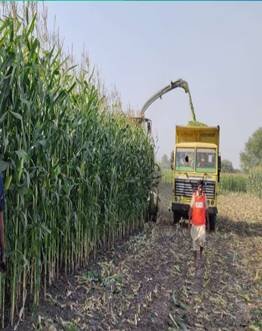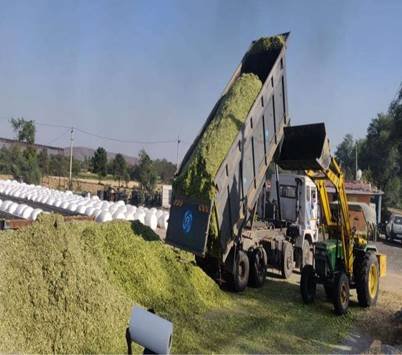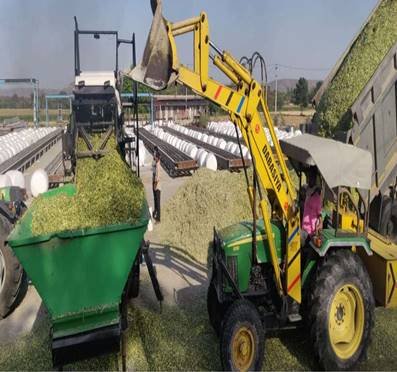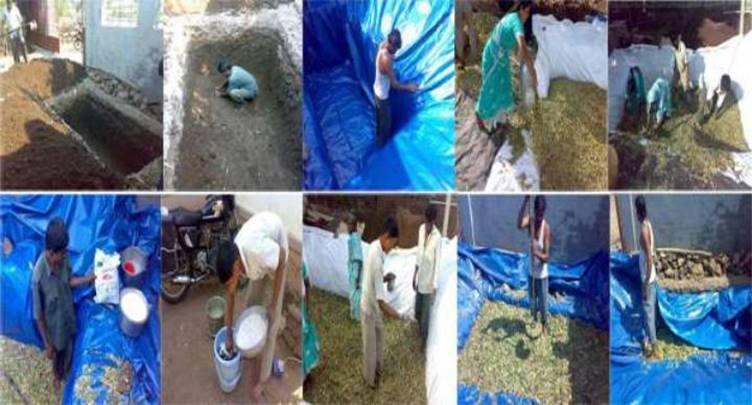ALL ABOUT SILAGE MAKING
Silage making means preservation of chaffed cereal green fodder in anaerobic condition by way of fermentation method. In anaerobic condition (no air inside pit/tank),with the help of micro organisms, sugar contained in green fodder is converted in to Lactic acid ,which help to preserve the green fodder for longer duration.
How Silage is Prepared?
During the silage making process, the pasture is cut when the grasses contain the highest nutrient levels. This level is attained just before they are fully mature. The reason why it is cut just before they are fully mature is that all forms of preserved grass, such as hay and silage, will have lower amounts of nutrients than fresh pasture, so everything must be done to make the end product be as nutritious as possible. During Silage preparation, the grass is allowed to wilt in the field for a few hours to reduce the moisture content to around 60-75% as this is the optimum level. If the grass is left out longer, it may get too dry, or it may get rained on – and both these will reduce the efficiency of the fermentation.
Process in Silage Making
1. Selection of Forage Crops and their Maturity Stage
The optimum dry matter for crop harvesting for silage depends on the stage of harvesting (Table 1). Most of crops are harvested at 50% flowering to dough stage when the moisture content varies between 18-22%. After overnight wilting the dry matter content become 30-35% which is proper dry matter content for ensiling. Table 1: Optimum stage for crop harvesting Common forage crops Stage of harvest Maize 50% flowering to dough stage Sorghum 50% flowering to dough stage Bajra 50% flowering to dough stage Oat Boot to dough stage
2. Steps in Silage Making
Silage making involves four major steps viz., harvesting and transportation, chaffing, filling and compaction and covering of silo.
2.1. Pit Making:
Firstly, a silage pit has to be dug for storing silage. The pit size may be determined based on the amount of silage to be stored. A pit with a dimension of 1 metre wide X 1 metre length X 1 metre depth can store 500 kilograms of silage. The location of pit should be free from water stagnation. The pit should be surrounded on all sides with thick plastic sheet. Pit can also be constructed using bricks and cement.
2.2. Preparation of Fermentation Mixture:
For preparing 1 ton silage, the following materials are required.
Jaggery or Molasses – 1 Kg
Salt – 1 Kg
Mineral Mixture – 1 Kg
DCP (Di-Calcium Phosphate) – 1 Kg
LAB (Lactic Acid Bacteria)
Urea – 1 Kg
Mix all of the above into a drum by adding water
2.3. Harvesting and Transportation of Crop (ensiling):
Harvesting at proper stage but delay in transportation may lead to loss of excess moisture results in haylage (DM 70-80%)

2.4 Chaffing:
It has to be chaffed into small pieces preferably 2-4 cm length using a chaff cutter. This improves the packing density which favours the growth of lactic acid bacteria, naturally present in crops. Add the fermentation mixture in small quantities as the fodder is loaded to chaff cutter. Position the chaff cutter so the chaffed fodder directly falls into the silage pit. Level the chaffed pieces evenly and press it hard so that all air comes out. Pressing and removing air is very important.

2.5. Filling of Silo and Compaction:
Chaffed material should be spread evenly over entire surface of silo (the structure) and then compacted through trampling (in case of small silo). In case of large silo (trenches) the compaction can be done using tractor. It helps in rapid evacuation of air from the silo, thus checks the aerobic respiration and nutrient loss.

2.6. Properly Sealing and Covering of Silo Pit:
It should be done in such a way that neither air enters in to the silo nor the gas comes out from the silo. It is better to use polythene sheet but care should be taken that entire surface of polythene sheet should be covered with straw or any other dried material up to 6-8 inch thickness to avoid the damage of polythene sheet by dog, cat or other animals. Make sure water does not enter the pit during rains. The silage will be ready in 45 to 60 days, depending on the types of material used. The silage of thin stem crop like oat becomes ready in 45 days while thick stem crops like maize, sorghum and bajra become ready in 60 days. Ideal silage is golden yellowish green colour with good aroma. After completion of incubation period the silo is opened for feeding. The whole silo should not be disturbed and it should be opened from one place/corner to avoid the loss of moisture and nutrients. Depending on the type of animal, stage of production and availability of silage it can be supplemented in the ration (5-25 kg per animal) of animal during lean period. After opening the pit, silage should be used within 30 days.

Essential Fodder Crops for Silage Making
To prepare best quality silage, cereal green fodder like Green fodder maize, Fodder sorghum, Bajara, Hybrid Napier, Sugar cane tops, Oat, Marwel etc are required. Preference for cereal green fodder (monocotyledons) is due to it has more sugar content than protein, as sugar is utilised in fermentation process to make lactic acid by microorganisms. These cereal fodder crops have hard stem, which takes more time for drying in making hay of these crops, so it is better to use these kinds of crops for making silage than hay.
Benefits of Slage Making
Silage is storage system of green fodder which keeps all parts of fodder in appropriate condition for feeding than any other system of storage of fodder. Silage requires less space for storage as it is pressed in pit/tank than hay making. For daily cutting, transporting & chaffing of fodder in traditional way requires more labour and time but in case of silage, fodder cutting, transport, chaffing is done at one time only, so it is less labour and time consuming practice.
Land under fodder cultivation is emptied, and immediately it is used for plantation of other crops. So farmers’ can take more crops in same land in a year against traditional way where land is reserved for fodder until all crops is harvested. Silage is prepared in closed and air tight condition so there is no danger of fire. (In hay making, dry fodder is stocked & exposed for fire like situation) Due to lactic acid in silage, it is easily digestible to animals, so energy required for digestion is used for other purposes like milk production.etc. Silage is tasty and flavoured, so it increases appetite of dairy animals. Important thing behind to adopt silage is in scarcity it provide supply of fodder to dairy animals. Situations like drought, high rainfall and scarcity of fodder, farmers may use silage for feeding to dairy animals. (Rain fed area where shortage of green fodder is for March to June & in high rainy area or water logged lands, it is impossible to cultivate or harvest fodder) Due to treatment of additive for silage, farmers can supply energy, mineral and vitamins to dairy animals.
Use of Silage
After 8-10 weeks, silage is ready as feed for animals. Open pit/tank initially from one side of for use. If it is not in use, then cover it carefully with plastic film so that air will not go inside in silage. Initially fed animals with 5-6 kg silage by adding it with chaffed green fodder to develop taste to animals. Once animal likes sweet-sour taste of silage; it will eat it with good liking.
Quality of Silage
Mould– If silage while filling pit/tank, not well pressed; there will be growth of mould.
Odour– Good quality silage has sweet & sour taste.
Colour– Good quality silage has faint green or brownish colour. Rotten silage has black colour.
pH– Good quality silage has pH of 3.5 to 4.2.
